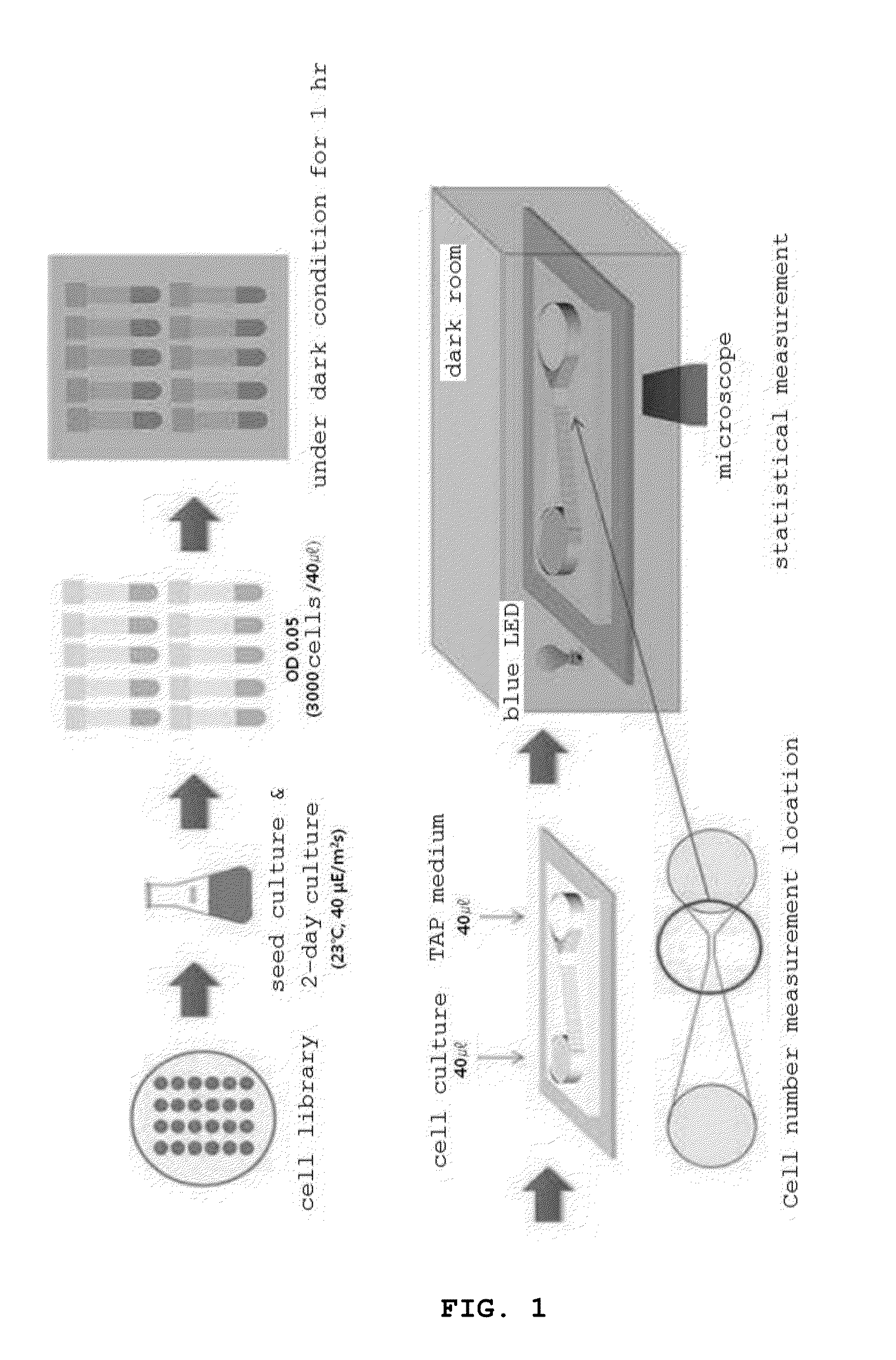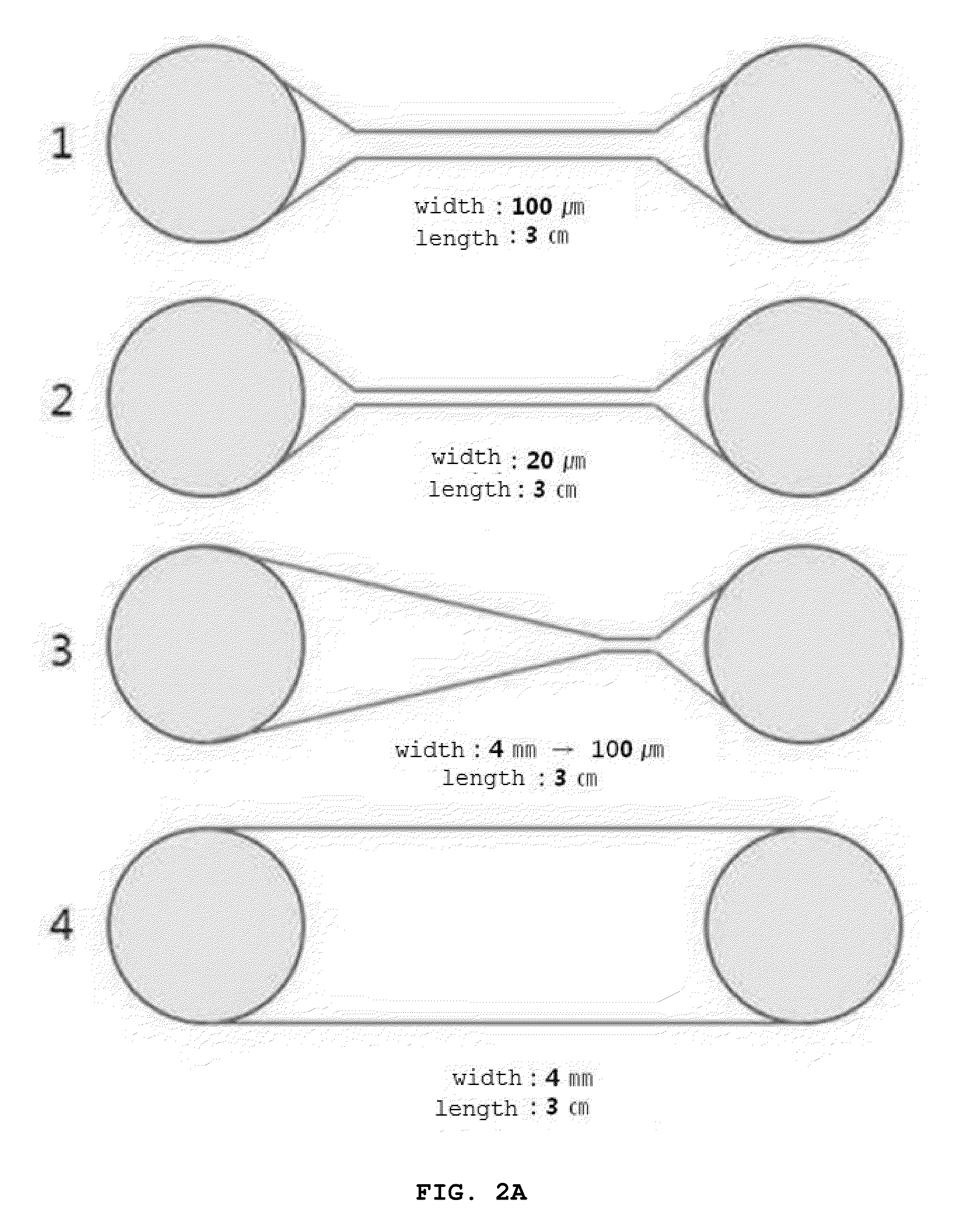Discrimination method for mutation-induced unicellular organism and microfluidic device used therefor
a single cell organism and microfluidic system technology, applied in the field of single cell organism screening and a microfluidic system, can solve the problems of complex biochemical and molecular biological analysis, difficult to improve strains to increase productivity, etc., and achieve rapid and efficient screening and increase the effect of respons
- Summary
- Abstract
- Description
- Claims
- Application Information
AI Technical Summary
Benefits of technology
Problems solved by technology
Method used
Image
Examples
example 1
Preparation of Mutant Strains
[0064]A strain used in this Example was Chlamydomonas reinhardtii species obtained from Professor Eon-Seon Jin (Hanyang University, Korea).
[0065]The strain was wild type strain JL428, and a random mutation was introduced into the wild-type strain by insertional mutation. Because it is generally known that strains having high chlorophyll a / b ratios are highly likely to have high photosynthesis efficiency (Anastasions Melis (2012) Vol. 158 930-945), strains having a chlorophyll a / b ratio higher than that of the wild type strain were selected and used to verify the effect of the inventive method.
[0066]The medium used in the culture of microalgae is a TAP medium containing the components shown in Table 1.
example 2
Culture of Microalgae and Fabrication of Microfluidic System
[0067]A microfluidic system was fabricated by photolithography by spin-coating negative photoresist SU-8 50 on a silicon substrate, covering the coated photoresist with a designed mask and exposing the photoresist to UV light using a UV exposure system. Polymer PDMS (polydimethylsiloxane) and a curing agent were mixed at a ratio of 10:1 and coated on the SU-8 mold fabricated by photolithography. The fabricated PDMS microfluidic system was combined with slide glass by plasma treatment. The fabricated system is shown in FIG. 2b.
[0068]In order to select the optimal channel structure of the system, the motility of cells at various channel widths and shapes as shown in FIG. 2a was analyzed as described in Example 3 below. In brief, while the cell inlet unit containing cells was exposed to light from a green LED light source (540 nm), the number of cells that reached the opposite side (i.e., cell reaching unit) located at a cert...
example 3
Analysis of Response of Microalgae to Light at Various Wavelengths of Light
[0069]In a pretreatment process for efficiently controlling the response and sensitivity of cells to light at constant levels, each of the Chlamydomonas reinhardtii wild type strain (JL428) and the mutant strains of Example 1 was seed-cultured in TAP agar medium. Specifically, each strain was cultured in TAP liquid medium under 24-hr light conditions at a light intensity of 40 μmol photon m−2s−1 and 23° C. for 2 days. After 2 days of culture, the cells reached the exponential phase, and the cells were diluted to a concentration of 7.5×103 cells ml−1 and stored in a dark room for 1 hour.
[0070]Next, 40 μl of the cells stored in a dark room for 1 hour were placed in the cell inlet unit of FIG. 2b, and 40 μl of TAP medium was placed in the cell reaching unit, after which the movement of the microalgal cells by phototaxis was observed by an inverted optical microscope in the measuring unit.
[0071]In order to analyz...
PUM
| Property | Measurement | Unit |
|---|---|---|
| wavelength | aaaaa | aaaaa |
| wavelength | aaaaa | aaaaa |
| diameter | aaaaa | aaaaa |
Abstract
Description
Claims
Application Information
 Login to View More
Login to View More - R&D
- Intellectual Property
- Life Sciences
- Materials
- Tech Scout
- Unparalleled Data Quality
- Higher Quality Content
- 60% Fewer Hallucinations
Browse by: Latest US Patents, China's latest patents, Technical Efficacy Thesaurus, Application Domain, Technology Topic, Popular Technical Reports.
© 2025 PatSnap. All rights reserved.Legal|Privacy policy|Modern Slavery Act Transparency Statement|Sitemap|About US| Contact US: help@patsnap.com



